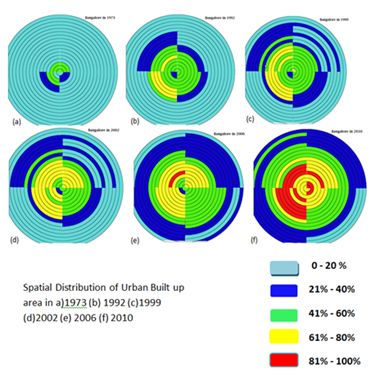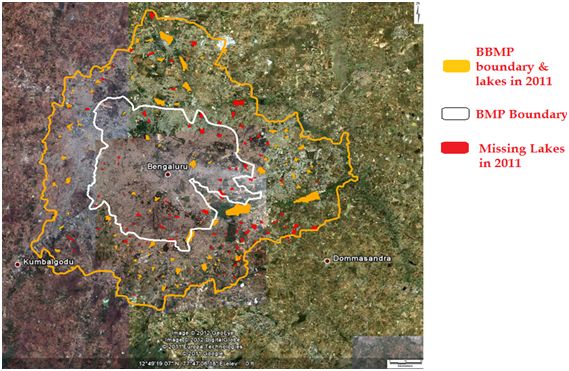|
Results and Discussion
Land use analysis for the period 1973 to 2010 has been done using Gaussian maximum likelihood classifier and the temporal land use details are given in table 2. Figure 3.1 provides the land use in the region during the study period. Overall accuracy of the classification was 72% (1973), 75% (1992), 71% (1999), 80% (2002), 73% (2006), and 86% (2010) respectively. Land use analysis was done using the open source programs (i.gensig, i.class, and i.maxlik) of Geographic Resources Analysis Support System (http://wgbis.ces.iisc.ac.in/ grass). From the classified raster maps, urban class was extracted and converted to vector representation for computation of precise area in hectares. There has been a 632% increase in built up area from 1973 to 2009 leading to a sharp decline of 79% area in water bodies in Greater Bangalore mostly attributing to intense urbanisation process. Analyses of the temporal data reveals an increase in urban built up area of 342.83% (during 1973 to 1992), 129.56% (during 1992 to 1999), 106.7% (1999 to 2002), 114.51% (2002 to 2006) and 126.19% (2006 to 2010). Figure 4 shows Greater Bangalore with 207 water bodies (in 1973), which declined to 93 (in 2010). The rapid development of urban sprawl has many potentially detrimental effects including the loss of valuable agricultural and eco-sensitive (e.g. wetlands, forests) lands, enhanced energy consumption and greenhouse gas emissions from increasing private vehicle use (Ramachandra and Shwetmala, 2009). Vegetation has decreased by 32% (during 1973 to 1992), 38% (1992 to 2002) and 63% (2002 to 2010).

Figure 3.1: Greater Bangalore in 1973, 1992, 1999, 2002, 2006, and 2010
Table 2: Greater Bangalore LC statistics
| Class |
Urban |
Vegetation |
Water |
Others |
| Year |
Ha |
% |
Ha |
% |
Ha |
% |
Ha |
% |
| 1973 |
5448 |
7.97 |
46639 |
68.27 |
2324 |
3.40 |
13903 |
20.35 |
| 1992 |
18650 |
27.30 |
31579 |
46.22 |
1790 |
2.60 |
16303 |
23.86 |
| 1999 |
24163 |
35.37 |
31272 |
45.77 |
1542 |
2.26 |
11346 |
16.61 |
| 2002 |
25782 |
37.75 |
26453 |
38.72 |
1263 |
1.84 |
14825 |
21.69 |
| 2006 |
29535 |
43.23 |
19696 |
28.83 |
1073 |
1.57 |
18017 |
26.37 |
| 2010 |
37266 |
54.42 |
16031 |
23.41 |
617 |
0.90 |
14565 |
21.27 |
Disappearance of water bodies or sharp decline in the number of water bodies in Bangalore is mainly due to intense urbanisation and urban sprawl. Many lakes (54%) were encroached for illegal buildings. Field survey of all lakes (in 2007) shows that nearly 66% of lakes are sewage fed, 14% surrounded by slums and 72% showed loss of catchment area. In addition, lake catchments were used as dumping yards for either municipal solid waste or building debris (Ramachandra, 2009a). The surrounding of these lakes have illegal constructions of buildings and most of the times, slum dwellers occupy the adjoining areas. At many sites, water is used for washing and household activities and even fishing was observed at one of these sites. Multi-storied buildings have come up on some lake beds that have totally intervene the natural catchment flow leading to sharp decline and deteriorating quality of water bodies. This is correlated with the increase in built up area from the concentrated growth model focusing on Bangalore, adopted by the state machinery, affecting severely open spaces and in particular water bodies. Some of the lakes have been restored by the city corporation and the concerned authorities in recent times.
Study area was divided into concentric incrementing circles of 1 km radius (with respect to centroid or central business district) in each zone as shown in Figure 3.2. This illustrates radial pattern of urbanization for the period 1973 to 2010. In 1973, the growth was concentrated closer to the central business district and was minimal. In 1992, Bangalore grew intensely in the NW and SW zones. This growth can be attributed to the policy of industrialization consequent to the globalization during early 90’s. Consequent to this, the industrial layouts came up in these areas specially in the NW and SW intensified the urban growth and as a result land was also acquired for housing and urban sprawl was noticed in others parts of the Bangalore. These phenomena intensified during post 2000 as the SE and NE Bangalore saw intense growth for development of IT and BT sectors. Subsequent to this, relaxation of FAR (Floor area ratio) in mid-2005, lead to the spurt in residential sectors, paved way for large scale conversion of land leading to intense urbanization in these localities. This also led to the compact growth at central core areas of Bangalore and sprawl at outskirts that are deprived of basic amenities. The gradient analysis showed that Bangalore grew radially from 1973 to 2010 indicating that the urbanization is intensifying from the city centre and has reached the periphery of the Greater Bangalore.

Figure 3.2: Gradient analysis of Greater Bangalore- Built-up density circle wise & zone wise from 1973 to 2010

Note -BMP: Bangalore MahanagaraPalike, BBMP: Bruhat Bangalore (Greater Bangalore) MahanagaraPalike
Figure 4: Greater Bangalore: 207 water bodies (1973), 93 water bodies (2010)
Erstwhile Bangalore city: 58 water bodies (1973), 10 water bodies (2010)
|




